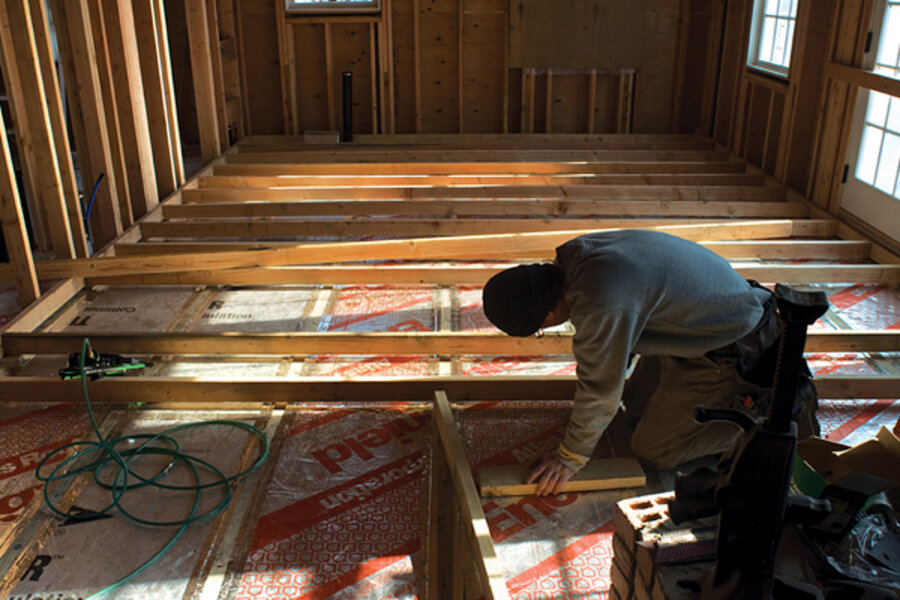Obama's 'Cash for Caulkers' boosts energy efficiency
Loading...
I thought I’d written my quota on the seemingly unsung merits of home insulation and weatherization in my most recent blog post. But today, President Obama is in Savannah, Ga., talking Cash For Caulkers, so I decided I just had to revisit the topic.
In the past Obama has also tried to bring some star quality to the prosaic subject of home weatherization. Last December, he actually went so far as to call insulation “sexy":
"I know the idea may not be glamorous,'' the president said, alluding to a recent round-table talk. "Someone said insulation is not very sexy. ... I disagree. ... Here's what's sexy about it: saving money.”
But abstract ideas just aren’t as persuasive as firsthand, real-life experience. So I decided to chat with someone who has actually spent the money to properly weatherize his home and is now a walking, talking advertisement for it.
Meet Robert Matto of RPM Energy Solutions. At Sheep Dog Hollow, the home we’re trying to renovate in as green and economical manner, he is our designated HERS rater.
HERS stands for Home Energy Rating Systems, and HERS raters are certified energy-efficiency experts whose job it is to test the energy efficiency of a home, suggest improvements – such as more insulation and better sealed windows – and then give the house a score or rating.
If you want to take advantage of most federal and state tax credits, rebates ,and special mortgages aimed at increasing home efficiency, you need a HERS rater.
The HERS standard is set by the Residential Energy Services Network (RESNET), which, according to its website is:
– An industry not-for-profit membership corporation.
– A national standards making body for building energy efficiency rating systems.
The site asks: Who recognizes RESNET standards?
▪ Mortgage industry for capitalizing energy efficiency in mortgages
▪ Financial industry for certification of "white tags"
▪ Federal government for verification of building energy performance for:
▪ Federal tax credit qualification
▪ EPA ENERGY STAR labeled homes
▪ U.S. Department of Energy Building America program
▪ States for minimum code compliance in 16 states
OK, OK … you can see why it’s difficult to bring attention to the insulation topic. It can get a bit obtuse, particularly since energy-efficiency rating is still a fairly new industry full of obscure acronyms like HERS and RESNET.
Unfortunately, one needs to understand them to understand Robert Matto’s job at Sheep Dog Hollow as well as why I call him a walking, talking advertisement for home insulation. He’s not only done up his own home, but his job is helping other people do it right.
So here’s his personal experience, which has made him a believer.:
His house was built in 1961 and is just over 2,000 square feet. The only insulation it had was some R-13 rated fiberglass batt insulation in the attic and some R-19 in an addition to the house
The first year he and his wife lived in the house, they burned 1,588 gallons of oil to heat the house. After five years of upgrades, which included an insulation overhaul, new windows, doors, a new roof, a new boiler, and “a whole lot of air-sealing,” his oil usage dropped down to between 425 to 475 gallons a year.
“Insulating my house was probably the biggest factor in saving money, but I did other stuff, too,” he says. “It took me about $18,200 in upgrades to do this, but my payback was in six years. I am still saving at least $2,000 to $3,000 a year in oil savings.”
The Cash for Caulkers program that Obama is touting today will cost about $6 billion dollars and make it possible for qualified homeowners to be eligible for up to $3,000 in instant rebates.
Matt Golden of the Home Star Coalition, which is lobbying hard to get Congress to pass Cash for Caulkers, says his group is also working with various state programs to make loans available to homeowners to help them pay for their upfront costs. [Editor's note: The original gave the wrong first name for Mr. Golden.]
While he, like Obama, touts the amazing green benefits and savings for individual homeowners, he, too, is pushing Cash for Caulkers primarily as a jobs bill. With 24 percent unemployment in the construction trades, Mr. Golden and the president both believe it's vital to get builders back on the job, and what better way than to retrofit and improve current homes?
Robert Matto, our HERS rater, also agrees, but he’s adamant that the program have proper oversight and standards… and not, he insists, just because it’s his job.
“It’s critical that the people administering it are certified – good oversight is the key,” he says. “There’s a lot of potential for people to get ripped off in this. If just anyone can do it, they could go into a house and say, ‘You need more insulation,’ when you really don’t because maybe they’re getting a kickback from an insulation company. ”
But he’s also adamant that a Cash for Caulkers program – properly insulated against fraud and abuse - is vital.
“Of the existing stock of homes, about 130 million of them – the majority of them – are poorly insulated or were built when tightness of homes wasn’t even a thought,” he says. “It could make a huge difference if done right.”
-----





